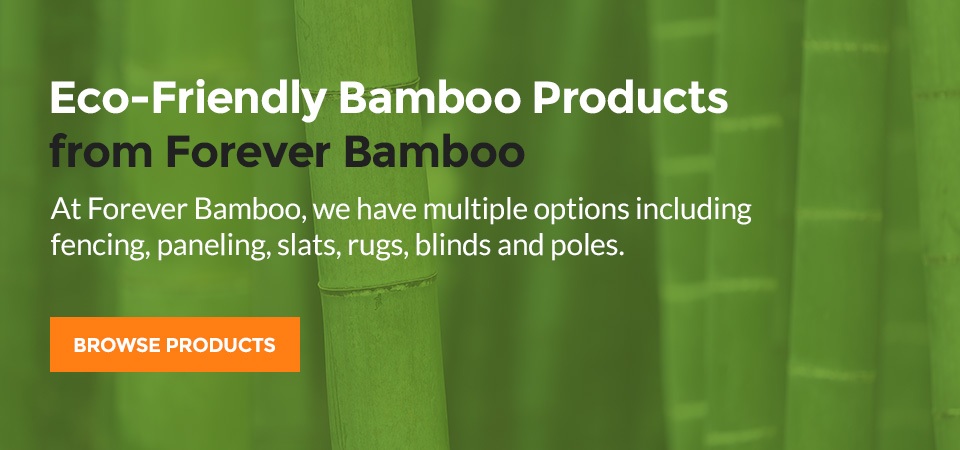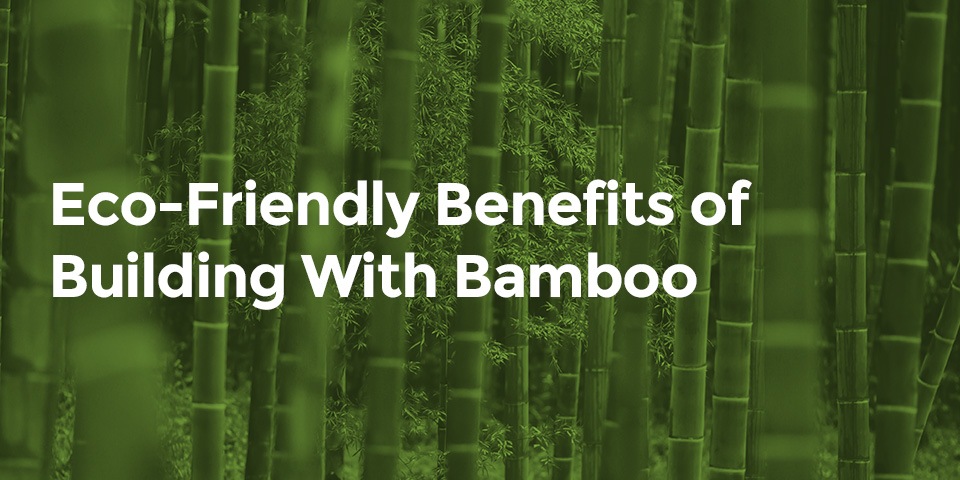
Bamboo has a myriad of uses for sustainable, eco-friendly building. Whether you want to construct tiki huts or bars, bamboo is a sturdy, outdoor wood option that will last. Unlike other forms of wood, bamboo has a low weight and sturdy structure. It proliferates, making it an ideal sustainable building product. Discover more about the ways bamboo benefits the environment and how you can make it your wood of choice.
Jump To Sections:
- How Is Bamboo Wood Sustainable?
- Why Is Bamboo Eco-Friendly?
- Sustainable Building With Bamboo
- Building Benefits of Bamboo Products
- Products to Use Bamboo as a Building Material
How Is Bamboo Wood Sustainable?
Sustainability reflects how much of a product people can use without significantly harming the chances of rejuvenation of the product. The following bamboo sustainability facts back up this definition by proving bamboo to be a renewable resource and wood-alternative to prevent deforestation.
1. Rapid Growth Prevents Deforestation
Bamboo grows rapidly in the right conditions. Though the planet has over 1,000 species and 45 genera of bamboo, one variety has a growth rate of 35 inches daily. While not all types grow as fast, bamboo still can rejuvenate forests quickly after harvest.
A bamboo forest can grow to maturity after planting in as little as seven years. Compare this to the three to five decades required for hardwood forests. By replacing forested areas faster, bamboo reduces deforestation, which is one of the things that makes bamboo a sustainable building material.
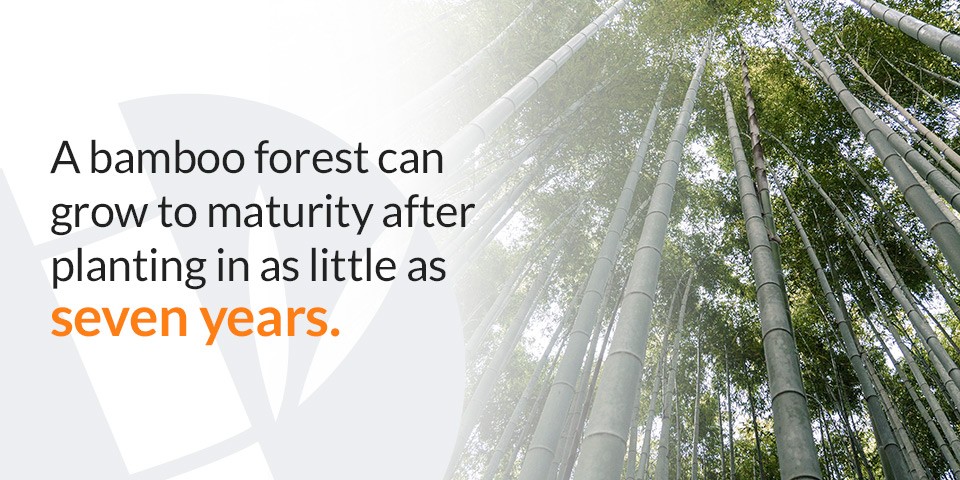
2. Plant Renewal Occurs Quickly
Technically, bamboo is a grass, and as such, many types grow from runners that connect all the plants in a grove. New shoots grow from the roots of the old growth. Since the runners remain underground, the soil experiences fewer disturbances during harvesting, which prevents erosion and keeps nutrients in the ground for the next generation of growth.
3. Multiple Growing Regions
Though more often associated with Asia, bamboo adapts well to a wide range of habitats. Hot tropical regions may be the stereotypical climate for bamboo, but these plants also make their homes on frigid mountaintops. Latitudes from 50 degrees north to 47 degrees south have bamboo natively growing.
With so many native areas, bamboo adapts well almost anywhere farmers introduce it. Though certain climates may not see equally rapid growth as in the plant’s native regions, it can still offer nearly effortless cultivation. In fact, many growers who plant the running type of bamboo, instead of clumping, find they must control the spread of the plant through above and below ground barriers to prevent it from taking over an area.
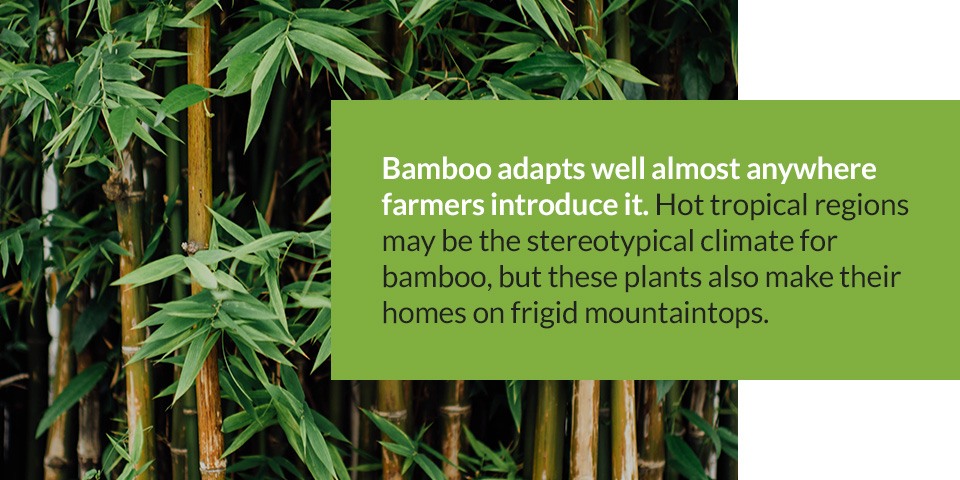
4. Grows Without Assistance
For farmers looking for a means of growing crops without paying the prohibitive costs of pesticides, herbicides and fertilizers, bamboo could become a solution. Most growers require minimal effort to get bamboo to grow quickly and densely. Since the roots hold water in the soil and prevent erosion, growers need less water and soil replenishments to help the crop grow. Without the need for poisonous pesticides or harmful herbicides, bamboo growing has a reduced effect on the environment compared to other plants that rely heavily on additives that could contaminate the nearby water supply.
Why Is Bamboo Eco-Friendly?
Sustainability makes bamboo an excellent building resource, but other factors make this wood an environmentally conscious building choice. Bamboo forests also help the planet, with more significant environmental benefits than other plants.
1. Increased Oxygen Production
Growing bamboo helps the environment as much as it does builders looking for a readily replenishing source of wood. The density of bamboo forests and the plant’s unique design allows these grasses, compared to trees, to produce 35% more oxygen.
When plant-filled forests get replaced with concrete-laden cities, the planet loses a portion of its oxygen-producing greenery. By planting bamboo in otherwise barren places, farmers can help make up some of that loss. Since the bamboo multiplies with ease, the planet more rapidly reaps the benefits of extra oxygen from the grass.
2. More Carbon Dioxide Uptake
With elevated levels of carbon dioxide contributing to global warming, planting bamboo forests could help. A hectare of a bamboo forest could use 12 metric tons — about 26,000 pounds — of carbon dioxide annually. Taking this much carbon dioxide from the atmosphere may help slow global warming.
Animals and people exhale carbon dioxide, but factories and cars also emit this gas. Increasing population and more fuel-burning factories mean the atmosphere has higher levels of carbon dioxide. With plants like bamboo to use some of this gas, the damage to the planet may slow.
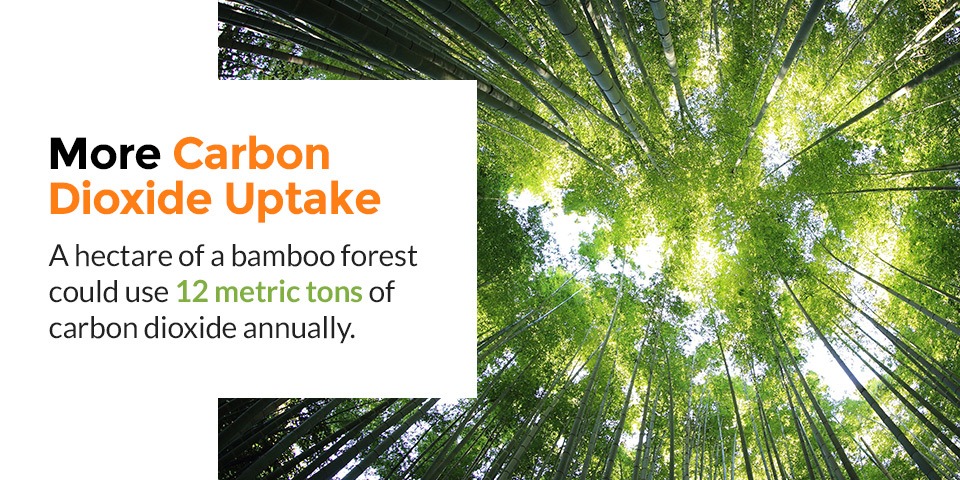
3. Forests Create Greenspaces for Wildlife
Creating bamboo forests allow endangered animals like pandas to travel between protected regions. Chinese researchers have planted bamboo corridors to link colonies of pandas to introduce genetic diversity into these groups, which will ensure the survival of the species in the wild.
The rapidly growing bamboo quickly produces a cover for animals to move. The low growing requirements of this grass make it a suitable choice for planting onto land worn out by agriculture. Where other plants won’t grow, the bamboo will, helping to reclaim land lost to overworking of the soil.
4. Soil Restoration After Overgrazing
Just as bamboo can grow in soil leeched of nutrients by agricultural overuse, it can also bring back soil after overgrazing. Recovering such land can help improve the environment by mitigating the effects of overuse of land by livestock. Typically, such property has few trees on it, making it susceptible to flooding and erosion when heavy rains occur. Bamboo’s root structure can hold the earth in place during torrential rain events, further preserving the environment.
5. Multiple Uses
Bamboo has a myriad of uses, making stands of this grass even more significant. People can use bamboo for more than just construction. Its applications include:
- Food: Bamboo shoots appear as ingredients in several Asian foods. Japanese food makers use bamboo to create preservatives.
- Paper: Like other woods, bamboo can become paper.
- Utensils: Disposable utensils and plates made from bamboo are better alternatives for the environment than those made from plastics.
- Furniture: Bamboo furniture has a unique appearance other woods cannot replicate.
- Charcoal: People in China and Japan have used bamboo for hundreds of years to create cooking fuel.
- Clothing: Fabric made from bamboo pulls moisture away and regulates temperature, making it ideal for fitness clothing and bedding.
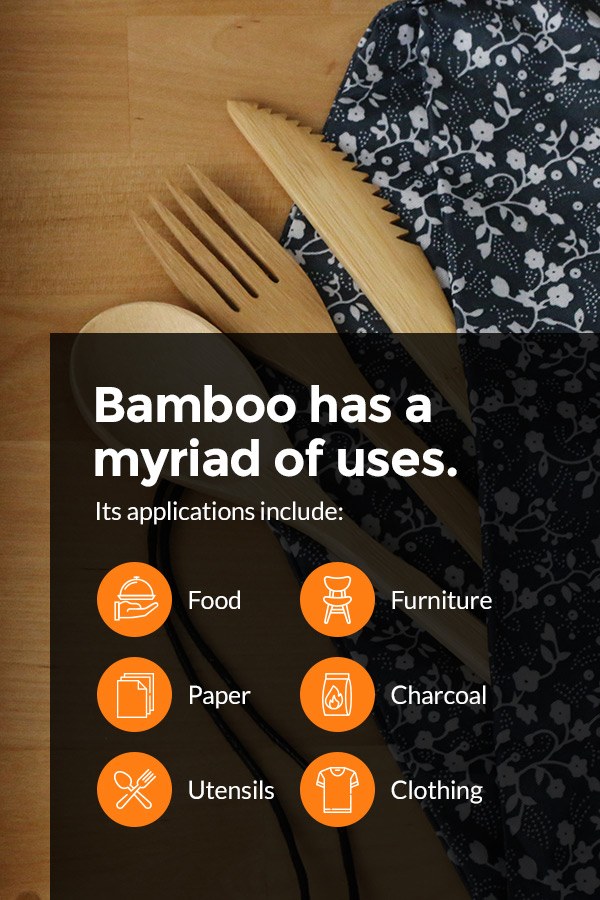
6. Reduces Water Pollution
The dense root system of bamboo prevents water from eroding topsoil during floods. Reducing erosion can protect nearby crops, as well. Keeping soil from washing away into nearby bodies of water is only one means that bamboo can prevent water pollution.
Another method of protecting water supplies comes from how bamboo uses nutrients in the soil. This grass consumes high amounts of nitrogen to grow. By taking in the nitrogen from the earth, bamboo prevents this substance from reaching water sources after it rains, helping to reduce water pollution in nearby waterways.
Sustainable Building With Bamboo
Bamboo has a sturdy structure and low weight to make it perfect for building outdoor conversation pieces. Create privacy fencing with bamboo or build a simple tiki bar with poles and more. Compared to other wood options for small constructions, bamboo offers multiple advantages that prove its sustainability and eco-friendliness.
1. No Paint Needed
Unlike other woods that require toxic finishes such as paint and varnish, bamboo’s natural beauty stands on its own. In fact, bamboo has a naturally hardy exterior that does not require varnish to seal or color it. For instance, the waxy surface of bamboo does not absorb paint the same way wood does.
Though you cannot use some topical finishes on bamboo, you don’t have to. Getting a beautiful natural building material without the chemicals of paint makes bamboo an eco-friendlier option compared to other woods that need chemical painting or sealing.
2. High Versatility
When it comes to construction materials, bamboo provides a high level of versatility. Though a grass, bamboo fibers can be formed into chipboard, flakeboard and medium-density fiberboards. Manufacturers can piece together cut bamboo to create wall paneling, flooring, privacy fencing, blinds and rugs. Even roofs with composite thermoplastic reinforcement may include bamboo in their construction.
With such versatility, each bamboo grove has more commercial uses from the same amount of land. When choosing bamboo for building, you encourage the production of this multi-use, sturdy and sustainable grass.
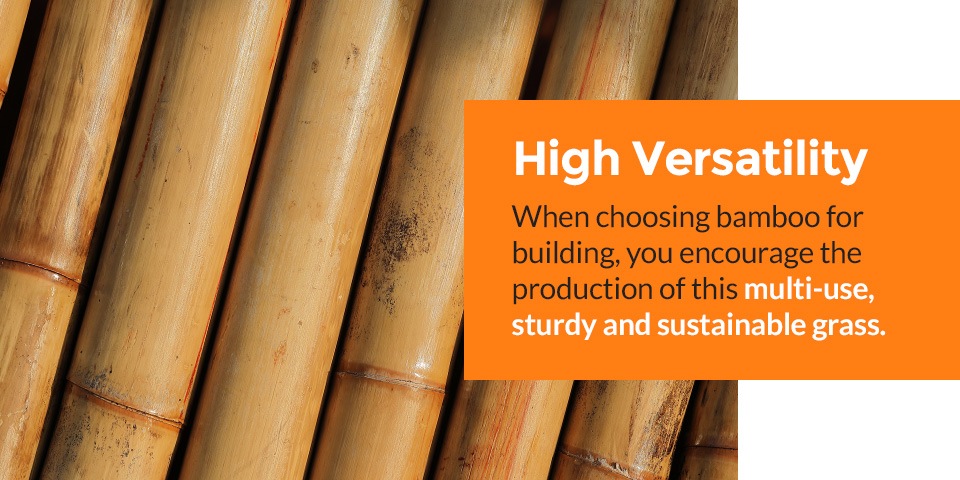
3. A Better Alternative
One way that bamboo is a sustainable choice is the quality alternative it offers to more environmentally damaging woods. For example, bamboo flooring can replace traditional hardwoods that require longer growing times, such as oak and maple. Depending on the type of bamboo flooring, though, it can match or near three times the hardness of oak.
Thanks to the lower environmental impact of bamboo, you can feel better knowing you have created a sustainable structure, whether you installed wall paneling or put up a fence in your backyard. The benefits of using bamboo products extend beyond sustainability, though, to include the strengths of the material itself.
Building Benefits of Bamboo Products
In addition to providing a sustainable alternative to other woods, bamboo offers multiple advantages to those who use it for building. The natural strength and flexibility of bamboo make it perfect for large and small projects. If you want an easy-to-work-with material that you can lift yourself, bamboo may be the ideal product for your next DIY effort.
1. Strength
Stronger than steel, bamboo can help support large structures without steel’s weight. Chinese road builders use bamboo to build bridges which can support 16-ton trucks. In India, bamboo helps reinforce roadways. Hong Kong construction workers opt for bamboo to create scaffolding because it costs less and more available than metal alternatives.
The Janka Hardness scale measures the effort needed to press a steel ball into a piece of material. The higher the number, the stronger the wood. Brazilian walnut ranks at the top of the scale with a rating of 3684. Eastern white pine, a common softwood, has a score of 380. Natural bamboo comes in the middle of the rankings with a score of 1380, making it harder than walnut, oak, ash and beech. Carbonized bamboo ranks lower at 1180, which still comes higher on the scale than walnut, birch, teak and cherry.
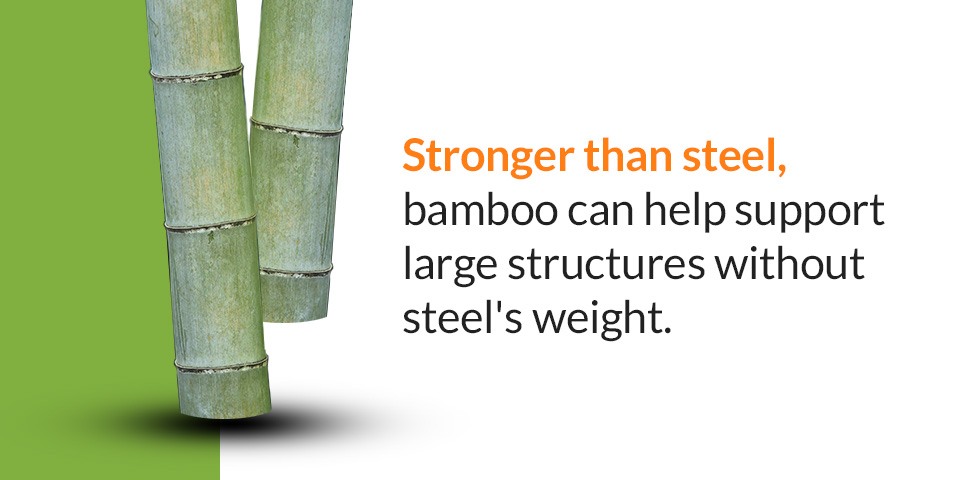
2. Disaster Resistance
When it comes to disasters, the materials used for construction will determine whether you will experience utter destruction or minor damage. Bamboo performs well in many disaster situations. For instance, the high silicate acid in bamboo makes it naturally flame resistant for specific varieties.
Depending on where you live, you may have to build with earthquakes in mind. The flexibility of building materials ensures movement during a quake instead of breakage. The natural suppleness of bamboo makes it an excellent choice for construction anywhere earthquakes occur. For instance, in 1992, a 7.5 magnitude earthquake struck Costa Rica. Homes built of bamboo were the only buildings left standing after the shaking stopped.
3. Light Weight
Bamboo’s high strength-to-weight ratio makes it perfect for DIY jobs and small construction projects. Unlike weightier woods, bamboo has a light enough weight that you may be able to complete many projects with it alone or with a single helper instead of requiring multiple people.
If you need durability without excessive weight, bamboo is the answer. This attribute of the grass makes it an excellent product for interior or exterior building projects.
Products to Use Bamboo as a Building Material
If you want to choose a more environmentally conscious material for your home improvement projects, bamboo is the answer. With so many forms for bamboo building material, this grass offers versatility along with beauty.
1. Paneling
When it comes to using bamboo for green building, paneling allows you to finish the walls or ceiling of your home with the durable, luxurious appearance of bamboo. If you appreciate the warm look of a tropical getaway, bamboo paneling will provide you with the design you crave.
With rolls of paneling available in 8- and 50-foot lengths and 4-foot heights, our bamboo paneling transforms any space into a relaxing, cozy area. Instead of flat walls, give your vertical spaces more texture and visual interest by installing paneling over the surfaces.
Choosing bamboo for a wall covering instead of painting or using hardwoods gives you a more environmentally friendly choice for your rec room, entertaining area or exterior patio.
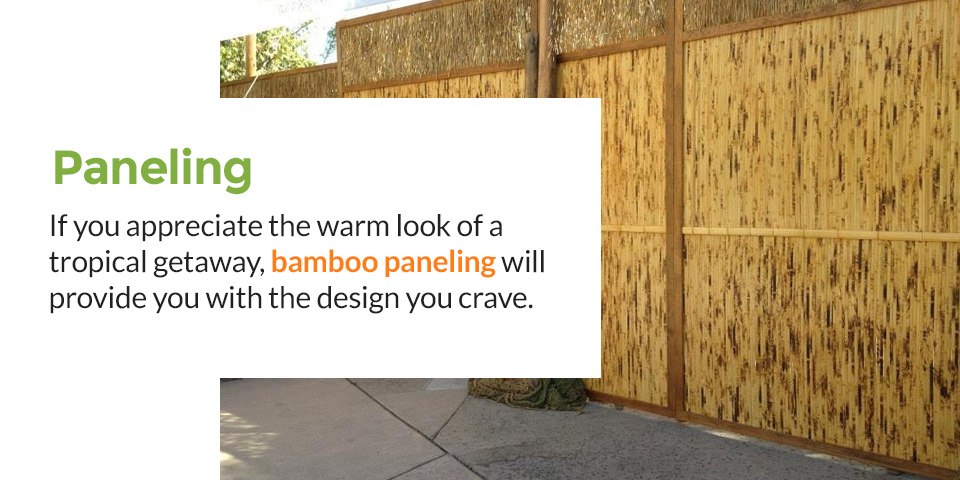
2. Fencing
If you have a backyard, you can embrace outdoor living. However, your existing yard design may not allow for much privacy from your neighbors. The design of a chain link and metal fences keeps them upright during heavy winds while providing extra protection from burglars. The downside to these fencing materials is how little they block the view of your backyard. Leave your regular fence in place for your home’s protection but cover the metal with bamboo fencing for more beauty and privacy.
Aside from covering fences, bamboo also hides tool sheds, air conditioner units, pool equipment and more from view. You can even transform any bar into an outdoor luau service with a covering of bamboo on the outside. Zoos often use bamboo fencing to provide areas of animal enclosures with some privacy from visitors. Restaurants may use fencing to surround exterior eating areas to hide them from the view of the parking lot or street without disrupting airflow or sunlight.
Installing bamboo fencing costs less and requires less effort than replacing your metal fence with one made of wooden boards. Choosing bamboo also means you have a more sustainable filter to offer some privacy for your backyard. The grass grows without pesticides or herbicides, making it better for the planet. Unlike plain wood, bamboo also gives your yard a tropical look, so you can imagine yourself on a trip to the islands without leaving your home.
3. Poles
Bamboo poles have a myriad of interior and exterior uses. Cut them down to size and construct whatever you can imagine from them with nails or glue. If you are a DIY enthusiast, bamboo is a superior material to work with because it’s more sustainable than hardwoods, is lightweight and has high strength. Create benches, trellises, light poles, railings and other accent pieces from bamboo poles. The only limit to what you can do is your imagination.
Because bamboo poles are natural products, expect variations in color, size and shape. Select from 5-, 8- or 10-foot lengths, left intact or halved. Both residential and commercial interiors can benefit from the natural beauty of bamboo for a warm, exotic look other woods cannot provide. If you want to create accent borders inside a business or in your garden, opt for bamboo borders, instead, to save yourself assembly time.
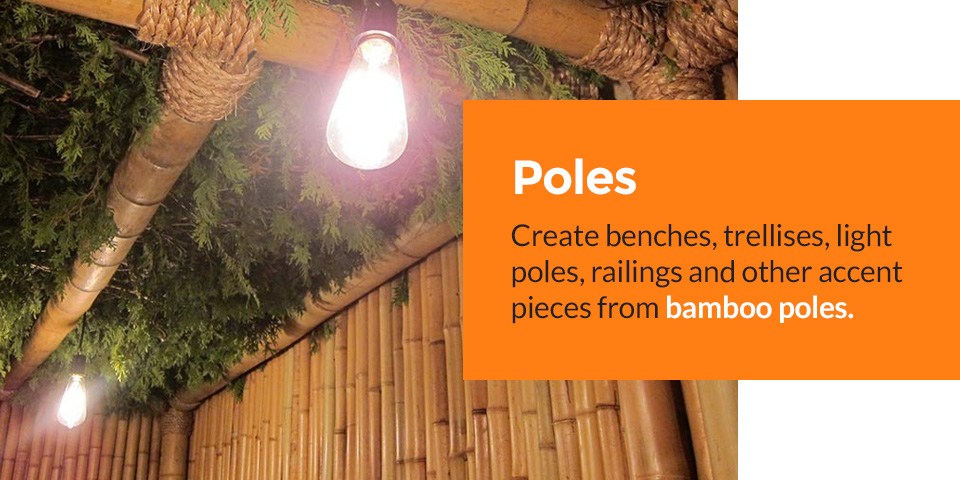
4. Borders
Bamboo borders come pre-assembled and install in less time than creating the same project from poles. Use these borders to accent areas of your exterior living space. Line sidewalks, set apart planting beds, ring trees and make accents for bamboo paneling.
To ensure the durability of your installed borders, use rebar sections measuring 1-foot long and up to one-half-inch in diameter for border supports. By putting in your own supports, you get the chance to form the borders to your needs and reinforce them once you place them. Golf courses, parks, zoos and gardens all can use bamboo edging in commercial settings.
Instead of using plastic edging that could leech chemicals into the soil, endangering the plants, bamboo edging gives you a natural option. Bamboo has a design that looks stunning without the need for artificial dyes or paint.
You can choose standard, which appears blond, or black. Instead of dying standard bamboo, our black bamboo comes from a variety with a naturally darker color. Since we don’t use dyes, you don’t need to worry about such products staining your sidewalks or contaminating your gardens.
5. Rugs
If you need a floor covering and want an Oriental rug, consider the environmental impact. Many Oriental rugs use exotic woods like mango in their production. Bamboo rugs give you a way to cover the floor with the beauty of bamboo wood without the need to cut down trees that require must longer to grow.
Available in a variety of colors and sizes, you will find a bamboo rug to fit your décor. Additionally, these rugs will help you decide if you want to invest in bamboo flooring. Or you could choose an area rug to get the look and feel of bamboo flooring without the cost. To maximize the longevity of these rugs, use them inside only.
Make Your Next Project an Eco-Friendly Build With Bamboo
Impart an exotic look to your home, inside or out with durable, beautiful bamboo. At Forever Bamboo, we have multiple options including fencing, paneling, slats, rugs, blinds and poles. Don’t be afraid to combine several of these to create different textures and looks. You can integrate these into indoor or outdoor spaces. No other material matches the flexibility, durability and appearance of bamboo. Check out our selection of high-quality bamboo products at Forever Bamboo for the materials you need for your next DIY project.

